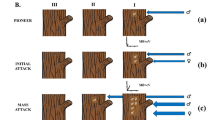Abstract
A visit to Northern China's forests on behalf of the German Agency for Technical Cooperation (GTZ) gave us the opportunity to report on some impressions. After a short description of the forestry situation overthere, a survey is given on the most important pest insects, vertebrates, and forest diseases, based on personal observations as well as on Chinese reports. Defense measures for forest protection include mainly chemical control, also silvicultural control, and recently more and more biological methods. In the report on the use of beneficial organisms, main emphasis is placed on the utilization ofTrichogramma dendrolimi to suppress the pine caterpillar (Dendrolimus spp.), the experimental use of two hymenopterous parasites,Scleroderma sp. andSchreineria sp., against the poplar borer (Saperda populnea) as well as the colonization of insectivorous birds and of weasels to suppress voles. It is also reported on the microbial control of pest insects using insect pathogenic viruses, bacteria, and fungi. Finally, some research projects on the use of antagonists against phytopathogens are mentioned.
Zusammenfassung
Eine im Auftrag der Gesellschaft für Technische Zusammenarbeit (GTZ) durchgeführte forstliche Reise nach Nordchina gab Anlaß, über einige der dabei erhaltenen Eindrücke und Kenntnisse zu berichten. Nach einer kurzen Darstellung der forstlichen Ausgangslage wird eine Übersicht über die wichtigsten beobachteten oder von chinesischer Seite aus erwähnten Schadinsekten, Schadwirbeltiere und Waldkrankheiten gegeben. Die Abwehrmaßnahmen im Rahmen des Waldschutzes umfassen in erster Linie chemische Bekämpfungen, ferner Kulturverfahren und, in steigendem Maße, biologische Methoden. Bei der Verwendung von Nutzorganismen wird besonders eingegangen auf den Einsatz vonTrichogramma dendrolimi gegen den Kiefernspinner (Dendrolimus-Arten), die Erprobung von zwei Schlupfwespen-Arten,Scleroderma sp. undSchreineria sp., gegen den Kleinen Pappelbock (Saperda populnea) sowie die Ansiedlung insektenfressender Vögel und die von Wieseln gegen Wühlmäuse. Ferner werden Angaben zur mikrobiologischen Bekämpfung von Schadinsekten mit insektenpathogenen Viren, Bakterien und Pilzen gemacht sowie abschließend einige Forschungsprojekte über den Einsatz von Antagonisten gegen phytopathogene Erreger vorgestellt.
Similar content being viewed by others
Literaturverzeichnis
Bauer, F., 1980: Volksrepublik China 1980 und Eindrücke einer Studienreise in 4 Provinzen des Landes der Mitte. Allg. Forstzeitschrift35, 1451–1453.
Butin, H., 1983: Krankheiten der Wald-und Parkbäume. G. Thieme, Stuttgart, 172 pp.
Franz, J. M., 1983: Biologischer und integrierter Pflanzenschutz in China. In:Halbach, U. (edit.): Ökologie in China. Berichte der ökologischen Außenstelle Schlüchtern11, 15–36.
Franz, J. M.;Krieg, A., 1980: Mikrobiologische Schädlingsbekämpfung in China—ein Reisebericht. forum mikrobiologie3, 173–176.
Hsiao, K., 1982: Forest entomology in China — a general review. Crop Protection1, 359–367.
Kuo, S.;Tang, F., 1981: The protective effect of several mycorrhizal fungi —Boletus sp. andSuillus grevillei on the damping-off disease of seedlings ofPinus tabulaeformis. Acta Bot. Yunnanica3, 359–366.
Ma, S., 1979: Integrated Control of Major Insect Pests in China. Beijing, 467 pp. (Orig. chin.).
McFadden, M. W.;Dahlsten, D. L.;Wayne Berisford, C.;Knight, F. B.;Metterhouse, W. W., 1981: Integrated pest management in China's forests. J. Forestry79, 722–726.
Qin, X.;Gao, R.;Xü, C.;Yao, D.;Li, Y.;Yian, J., 1982: Studies on the mass-rearing and release of Bethylid parasitic wasp (Scleroderma sp.) in Beijing area. Scientia Silvae Sinicae18, 209–213 (Orig. chin.).
Scheifele, M., 1980: Walderneuerung und Waldschutz in der VR China. Allg. Forstzeitschrift35, 1461–1463.
Su, T., 1982: Use of bacteria and other pathogens to control insect pests in China. In:Kurstak, E. (edit.): Microbial and Viral Pesticides. M. Dekker Inc., New York, Basel, 317–332.
Tsai, P.;Jen, G.;Sun, H.;Wang, C., 1964: A preliminary test on the application of a bacterial insecticide (Bacillus thuringiensis var.thuringiensis) to control the pine caterpillarDendrolimus punctatus Walk. Acta Ent. Sinica13, 855–861.
Tsai, P.;Hou, T.;Hwang, F., 1979: On the practice and perspectives of integrated control of forestrial insect pests: “pine caterpillars” in China. Acta Ent. Sinica22, 45–52.
USDA, 1982: Biological Control of Pests in China. USDA — Office of Intern. Cooperation and Development, Scientific and Technical Exchange Division. China Program. Washington, D, C., 268 pp.
Wu, C., 1981: Forest research and its prospects in the People's Republic of China. J. Forestry79, 529–533.
Author information
Authors and Affiliations
Rights and permissions
About this article
Cite this article
Franz, J.M., Zimmermann, G. Probleme des Waldschutzes in Nordchina mit besonderer Berücksichtigung biologischer Verfahren. Anz. Schadlingskde., Pflanzenschutz, Umweltschutz 57, 81–87 (1984). https://doi.org/10.1007/BF01906830
Issue Date:
DOI: https://doi.org/10.1007/BF01906830




